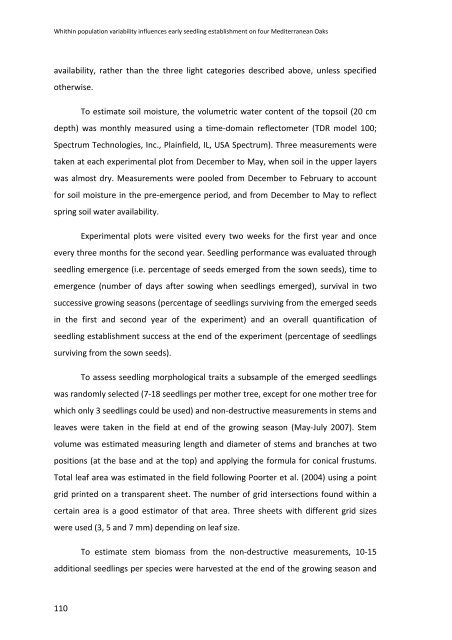Establecimiento de cuatro especies de Quercus en el sur de la ...
Establecimiento de cuatro especies de Quercus en el sur de la ...
Establecimiento de cuatro especies de Quercus en el sur de la ...
Create successful ePaper yourself
Turn your PDF publications into a flip-book with our unique Google optimized e-Paper software.
Whithin popu<strong>la</strong>tion variability influ<strong>en</strong>ces early seedling establishm<strong>en</strong>t on four Mediterranean Oaks<br />
avai<strong>la</strong>bility, rather than the three light categories <strong>de</strong>scribed above, unless specified<br />
otherwise.<br />
To estimate soil moisture, the volumetric water cont<strong>en</strong>t of the topsoil (20 cm<br />
<strong>de</strong>pth) was monthly mea<strong>sur</strong>ed using a time‐domain reflectometer (TDR mo<strong>de</strong>l 100;<br />
Spectrum Technologies, Inc., P<strong>la</strong>infi<strong>el</strong>d, IL, USA Spectrum). Three mea<strong>sur</strong>em<strong>en</strong>ts were<br />
tak<strong>en</strong> at each experim<strong>en</strong>tal plot from December to May, wh<strong>en</strong> soil in the upper <strong>la</strong>yers<br />
was almost dry. Mea<strong>sur</strong>em<strong>en</strong>ts were pooled from December to February to account<br />
for soil moisture in the pre‐emerg<strong>en</strong>ce period, and from December to May to reflect<br />
spring soil water avai<strong>la</strong>bility.<br />
Experim<strong>en</strong>tal plots were visited every two weeks for the first year and once<br />
every three months for the second year. Seedling performance was evaluated through<br />
seedling emerg<strong>en</strong>ce (i.e. perc<strong>en</strong>tage of seeds emerged from the sown seeds), time to<br />
emerg<strong>en</strong>ce (number of days after sowing wh<strong>en</strong> seedlings emerged), <strong>sur</strong>vival in two<br />
successive growing seasons (perc<strong>en</strong>tage of seedlings <strong>sur</strong>viving from the emerged seeds<br />
in the first and second year of the experim<strong>en</strong>t) and an overall quantification of<br />
seedling establishm<strong>en</strong>t success at the <strong>en</strong>d of the experim<strong>en</strong>t (perc<strong>en</strong>tage of seedlings<br />
<strong>sur</strong>viving from the sown seeds).<br />
To assess seedling morphological traits a subsample of the emerged seedlings<br />
was randomly s<strong>el</strong>ected (7‐18 seedlings per mother tree, except for one mother tree for<br />
which only 3 seedlings could be used) and non‐<strong>de</strong>structive mea<strong>sur</strong>em<strong>en</strong>ts in stems and<br />
leaves were tak<strong>en</strong> in the fi<strong>el</strong>d at <strong>en</strong>d of the growing season (May‐July 2007). Stem<br />
volume was estimated mea<strong>sur</strong>ing l<strong>en</strong>gth and diameter of stems and branches at two<br />
positions (at the base and at the top) and applying the formu<strong>la</strong> for conical frustums.<br />
Total leaf area was estimated in the fi<strong>el</strong>d following Poorter et al. (2004) using a point<br />
grid printed on a transpar<strong>en</strong>t sheet. The number of grid intersections found within a<br />
certain area is a good estimator of that area. Three sheets with differ<strong>en</strong>t grid sizes<br />
were used (3, 5 and 7 mm) <strong>de</strong>p<strong>en</strong>ding on leaf size.<br />
To estimate stem biomass from the non‐<strong>de</strong>structive mea<strong>sur</strong>em<strong>en</strong>ts, 10‐15<br />
additional seedlings per species were harvested at the <strong>en</strong>d of the growing season and<br />
110

















